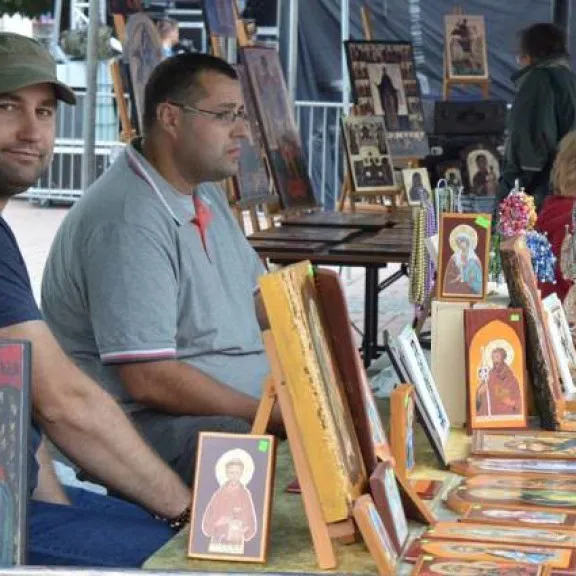

Following the trail of icons from Sanok to Humenne
Beneficiary: Sanok City Commune
Slovak partner: City of Humenné
Implementation period: 01/04/2017 - 31/03/2018
Realized project value: € 72 348.65 , including ERDF co-financing: € 61 496.35 ,
The Historical Museum at the Castle in Sanok is famous for the richest collection of icons in Poland. No wonder then that a small town in Podkarpacie was the beginning of the route of these unique paintings, which leads all the way to Humenne in Slovakia. However, over the years, the Trail has become less and less attractive to tourists, which is why the cities responsible for its maintenance have decided to modernize this local attraction. As part of the activities, the infrastructure was supplemented with an information system on objects on both sides of the border, the so-called QR codes. The fair in Sanok also contributed to the promotion of cultural heritage, during which you could admire crafts and artistic products as well as taste local specialties. For the purposes of the project, a series of publications were created, including a tourist guide and a website for the Trail of Icons with the possibility of geolocation. The Slovak micro-project partner took care of the publication of a map with a marked bicycle trail and interesting places in the border region. There were also workshops on the sustainable development of natural and cultural heritage. On the other hand, in the open-air museum in Humenne, an open-air exhibition presenting folk art was prepared.
The main activities carried out under the project:
-
Modernization of the Bicycle Trail of Icons on the Polish side - the task was completed on the 100 km section from Ulucz to the border with Slovakia. From the main route, side routes were made to the following villages: Łodzina, Czerteż, Wisłok Wielki, Smolnik n / Osława, Rzepedź (village) and to the Sanok district - Olchowce. The modernization of the trail consisted of supplementing signs painted on trees and other objects, as well as supplementing direction boards, poles and information boards about the objects. The trail has also been supplemented with GPS coordinates and QR codes.
-
Modernization of the Icon Bicycle Trail on the Slovak side - as part of the task, the Icon Trail was marked. The route starts in the center of Humenné at the crossroads of several bicycle routes near the Renaissance chateau. The first kilometers lead along the streets of the city, then on the road II / 559. The route continues and gradually passes through the villages along the route towards Medzilaborce. The first major attraction along the route are the ruins of the monastery church and monastery, Monastyr, and then Medzilaborce, where the route passes through the city center next to the A. Warhol Museum. Then the route ascends to the Carpathian ridge to the Laborecki saddle, where the route ends at the border with Poland. There are several World War I cemeteries in the entire area. The entire route is 53.3 km long.
-
The promotion of cultural heritage on the Polish side was divided into several activities. A fair was organized in Sanok to promote the cultural heritage of the Polish-Slovak borderland. Stands presented crafts, artistic products and cuisine. The fair was held in the Market Square in Sanok and the adjacent streets. Traditional publishing houses were part of the activities promoting the Polish-Slovak cultural heritage. Namely, the brochures (published in Polish, Slovak, German, English and French) and a tourist guide on the Trail of Icons. These activities were supplemented by the creation of a website dedicated to the Trail of Icons and the development and embossing on DVDs of a virtual walk around selected objects of the trail.
-
Promotion of cultural heritage on the Slovak side , as part of which an open-air session devoted to folk art and writing icons was organized in Humenne, under the direction of Dorota Filip from the Pracownia from the icon of St. Cross in Sanok. The plein-air participants had the opportunity to try out the way of writing icons in a traditional way. In addition, promotional materials were published in the form of a map showing the course of the bicycle route along with attractions on the route between the state border (PL-SK) and Humenne, a publication on valuable border objects on the Slovak side and a tourist guide. The Humenné Tourist Information Center was also renovated. At the end of the project, a conference and workshops were organized to exchange experiences in the field of sustainable development of the natural and cultural heritage of the Polish-Slovak borderland.
We encourage you to watch material broadcast on TVP 3 Rzeszów











